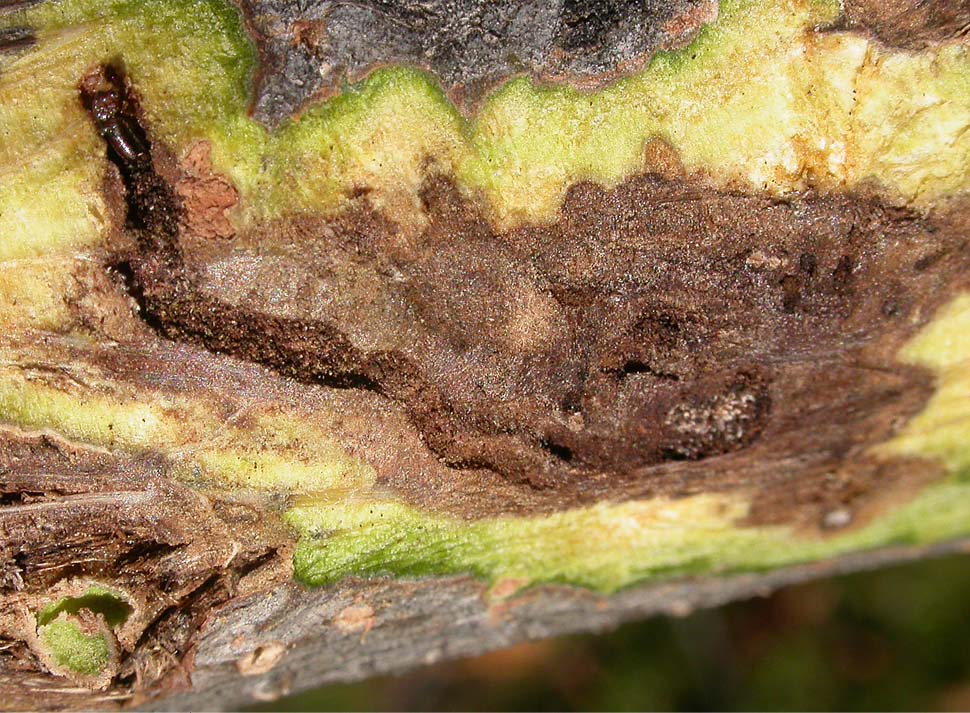Thousand Cankers Disease (TCD) is a new disease affecting the Walnut genus, causing significant damage, particularly to Black Walnut.
Deadly to Black Walnut
Relatively harmless to Walnut species within the Walnut Twig Beetle’s native range, TCD is devastating to eastern members of the Juglans genus such as Black Walnut. Thousand Cankers Disease has not yet appeared in Ohio, but researchers have discovered the Walnut Twig Beetle, and officials are currently making great efforts to prevent TCD from infecting and destroying our Black Walnut trees.
The Walnut Twig Beetle (WTB) transports the Geosmithia morbida fungus to host trees. This ultimately causes the mortality of infected trees. The Walnut Twig Beetle introduces the fungus to a tree as it burrows into and overwinters within the bark. It also spreads through the layers of the host tree, helping the spread of Thousand Cankers Disease.
Walnut canker disease
Once the adult beetle has emerged, spores deposited within the tree grow rapidly around the exit wound. This occurs on the side of the infected tree. Each time a beetle bores into the tree, it initiates cankers. Over time, a small number of cankers grows into many. This ultimately disrupts the tree’s cambium. Though Walnut canker disease it is not clear how the disease began, what is clear is that this disease is detrimental to eastern Black Walnut populations. It threatens a valuable economic and ecological resource, contributing to the Thousand Cankers Disease outbreak.
Thousand Cankers Disease
The Walnut Twig Beetle is native to Mexico and parts of Arizona, New Mexico, and California. While western species of the Walnut genus, such as Arizona Walnut and Northern California Walnut, are highly resistant or even immune to the disease. On the other hand, Black Walnut canker disease is pervasive throughout the eastern hardwood forest. It has a high degree of mortality when confronted with TCD. Researchers first observed this susceptibility in regions affected by Thousand Cankers Disease, within Black Walnut groves located in California.
Timber Quarantines Loom
…for a second year in a row the Walnut Twig Beetle has been found in Butler County, Ohio and for the first time ever in our state a quarantine on Walnut trees located within Butler County has been implemented.Unlike the Emerald Ash Borer currently affecting Ohio’s Ash population, TCD is hard to recognize and shows few visible signs within infected trees early on in the disease-cycle.
In fact, by the time symptoms are noticeable, tree death can occur in as little as three years. The first sign of TCD is yellowing in the canopy. This is followed by sudden leaf wilting in branches or the entire canopy. Thousand Cankers Disease lives up to its name, slowly attacking the tree.
Living up to its name, the disease is slow and methodical in the manner with which it ultimately kills a host Walnut tree. Small cankers form at the site of each beetle attack. Over time, the number of cankers on a tree grows. This is as more and more Walnut Twig Beetles bore into its bark and cambium.
Although TCD has not yet appeared in Ohio Walnut populations, researchers have discovered it in three eastern states: Tennessee, Pennsylvania, and Virginia. However, for a second year in a row, researchers have found the Walnut Twig Beetle in Butler County, Ohio. For the first time ever in our state, officials have implemented a quarantine on Walnut trees located within Butler County to prevent Thousand Cankers Disease.
Timber Owners Be Watchful
For now, we watch the development of this disease with cautious optimism that quarantines will be effective against the spread of the disease. The Black Walnut population throughout our region’s hardwood forest would be a terrible thing to lose—in addition to providing valuable nutrients to native wildlife populations, these trees produce beautiful, classically-enduring lumber used in furniture, flooring and cabinets. Thousand Cankers Disease threatens this invaluable resource.
The USDA estimates the value of the Black Walnut stand located in the eastern United States at 500 billion dollars. Losing such a valuable resource would be a terrible turn for our forests.

